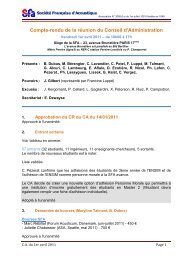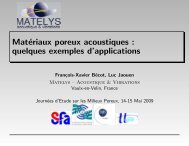Programme et inscription (pdf) - SFA
Programme et inscription (pdf) - SFA
Programme et inscription (pdf) - SFA
Create successful ePaper yourself
Turn your PDF publications into a flip-book with our unique Google optimized e-Paper software.
Cloture des journées:<br />
P<strong>et</strong>r Janata (Center for Mind and Brain University of California, Davis)<br />
The fact that we often use various adjectives, e.g. pure, rough, dark, flowing, to describe different<br />
timbres suggests that sounds and words activate a common semantic system which facilitates such<br />
comparisons. Perhaps the clearest example is for environmental sounds, where the sound that an<br />
object makes is a clear referent to that object. However, the semantic relationship b<strong>et</strong>ween musical<br />
timbres and more abstract concepts is not well understood. I will describe some recent studies in my<br />
lab that try to look at such mappings. The basic approach is to ask subjects to rate the similarity<br />
b<strong>et</strong>ween sound and word pairs, word and word pairs, or sound and sound pairs, using a library of 60<br />
sounds and 60 words. We then perform factor analysis on the average similarity matrix in hopes of<br />
recovering the factor structure of the semantic space in which the items are compared. The results<br />
suggest that words and sounds are being compared along dimensions of valence and different forms<br />
of arousal, consistent with earlier studies of semantic and emotional structure. When considered in<br />
terms of acoustic attributes, groups of sounds do form clusters within the factor structure for some<br />
attributes, though individual acoustic dimensions are not aligned specifically with individual<br />
factors.<br />
14- <strong>Programme</strong> des Journées Perception Sonore, Lyon, 18-19 janvier 2007






